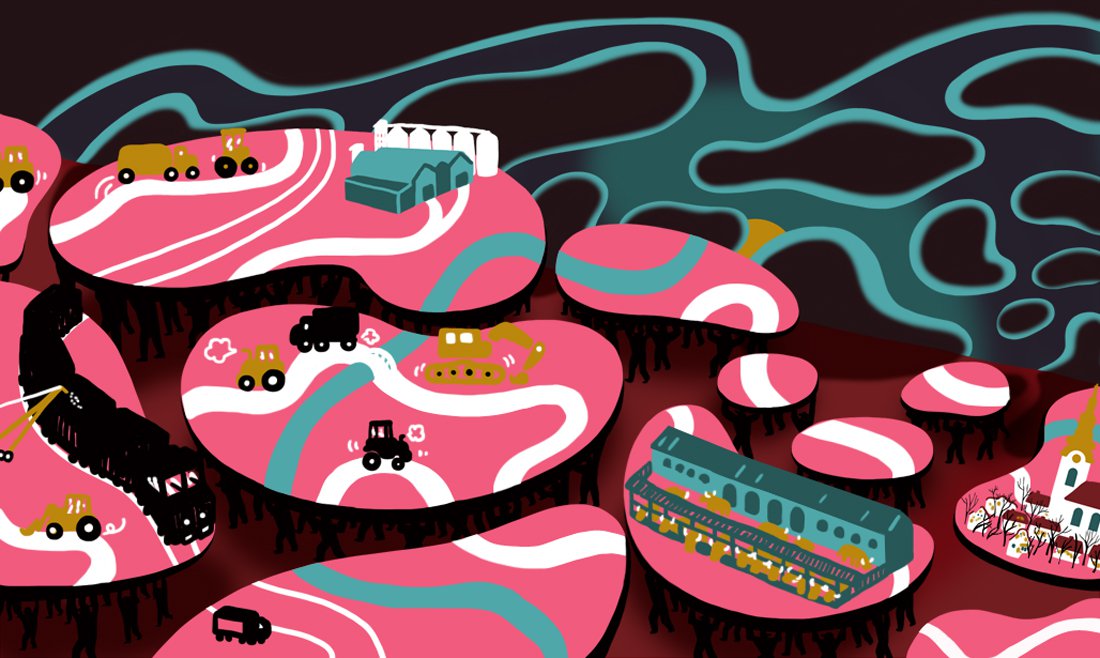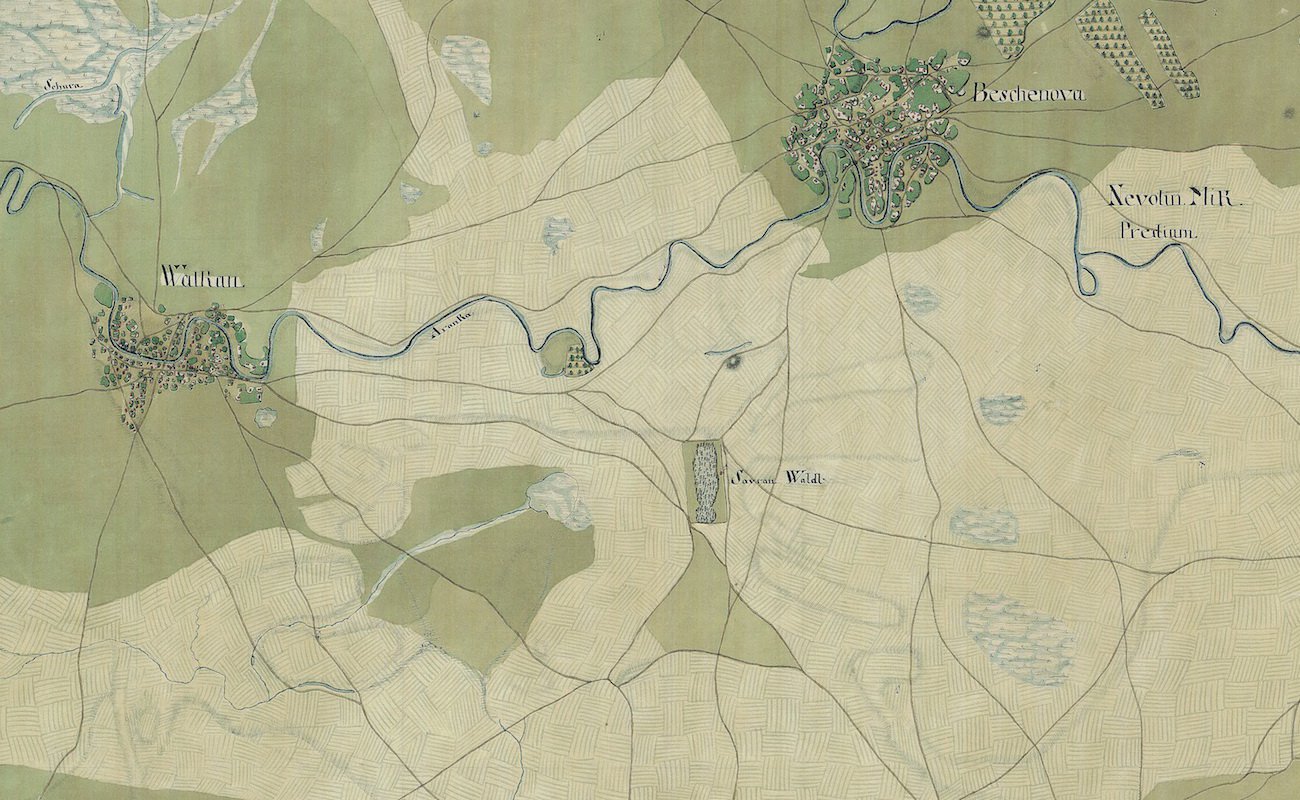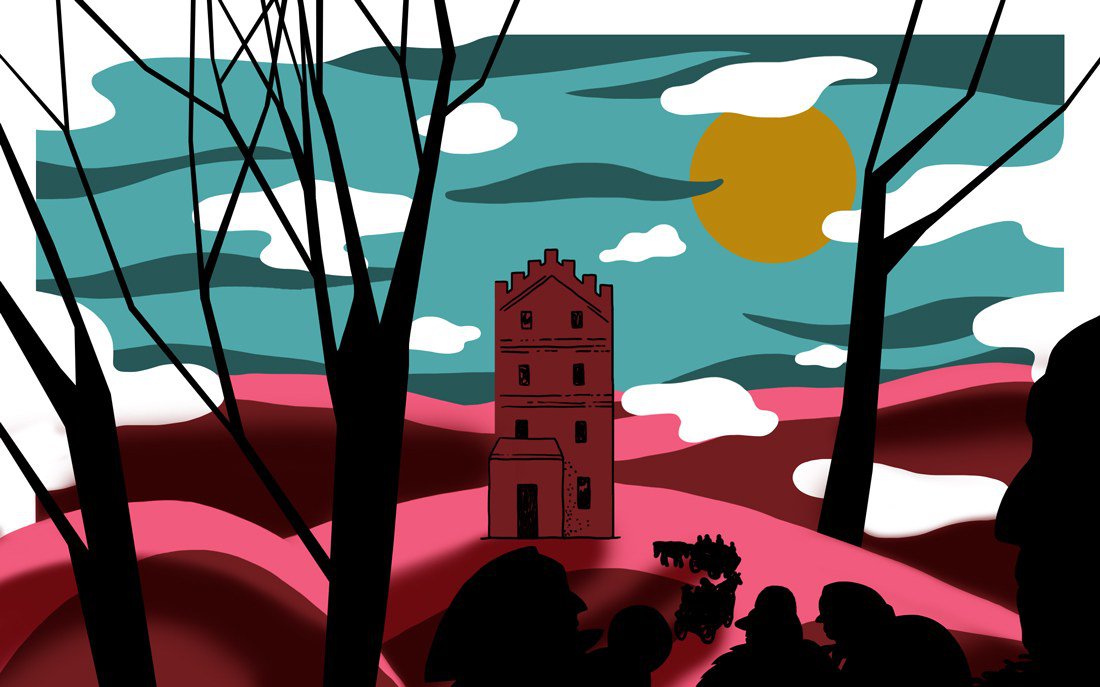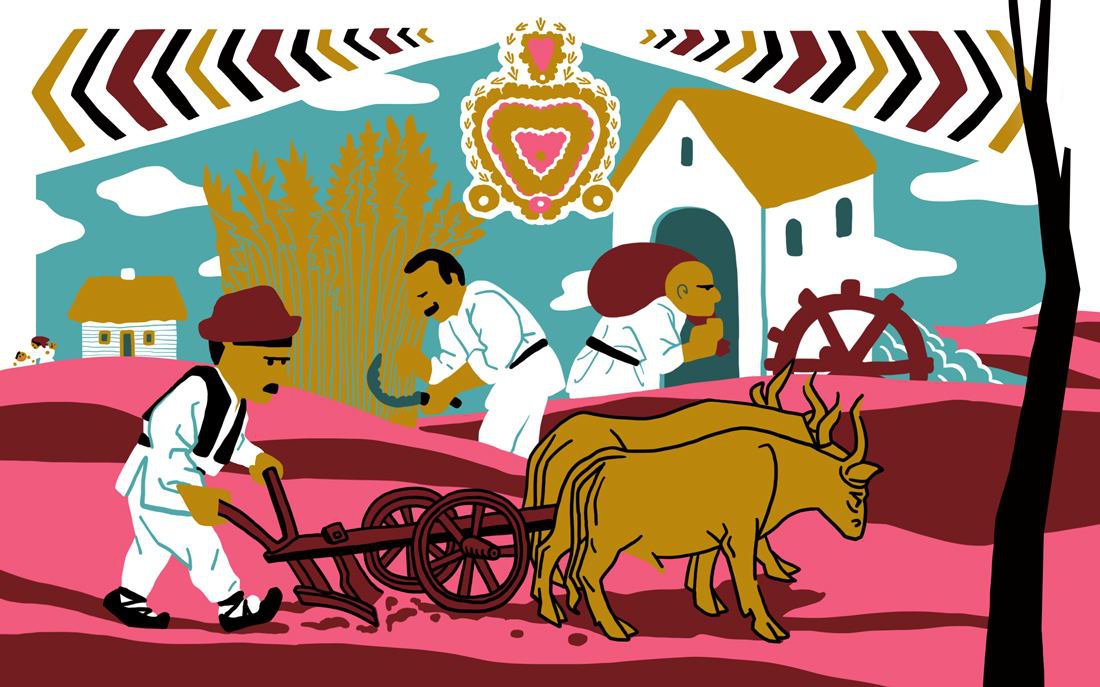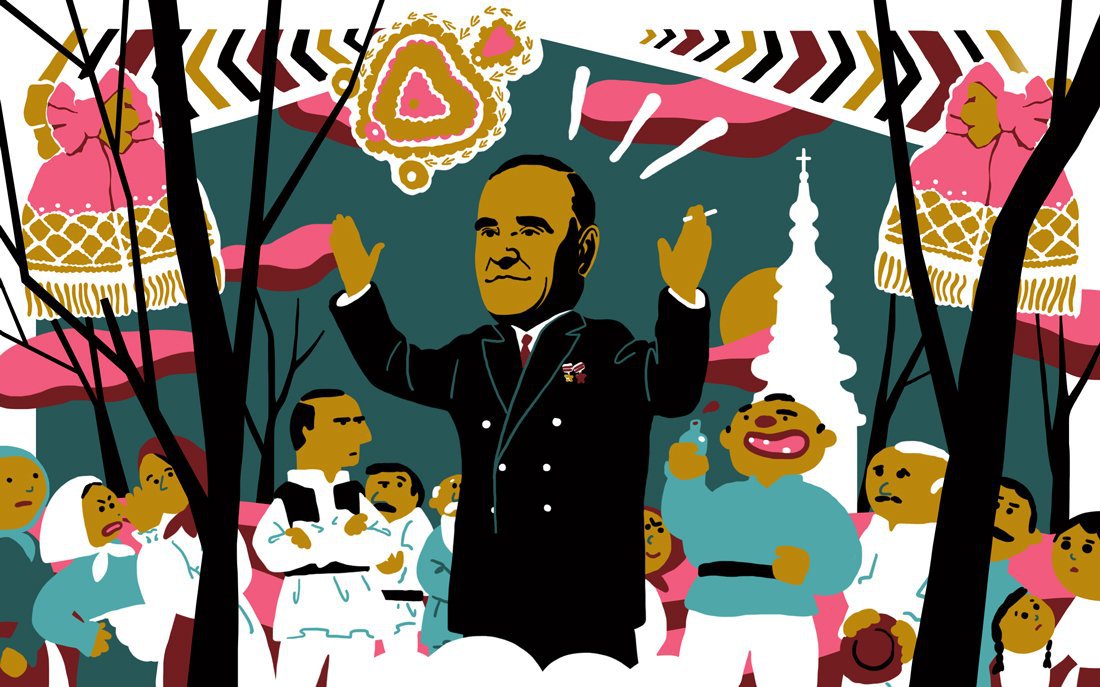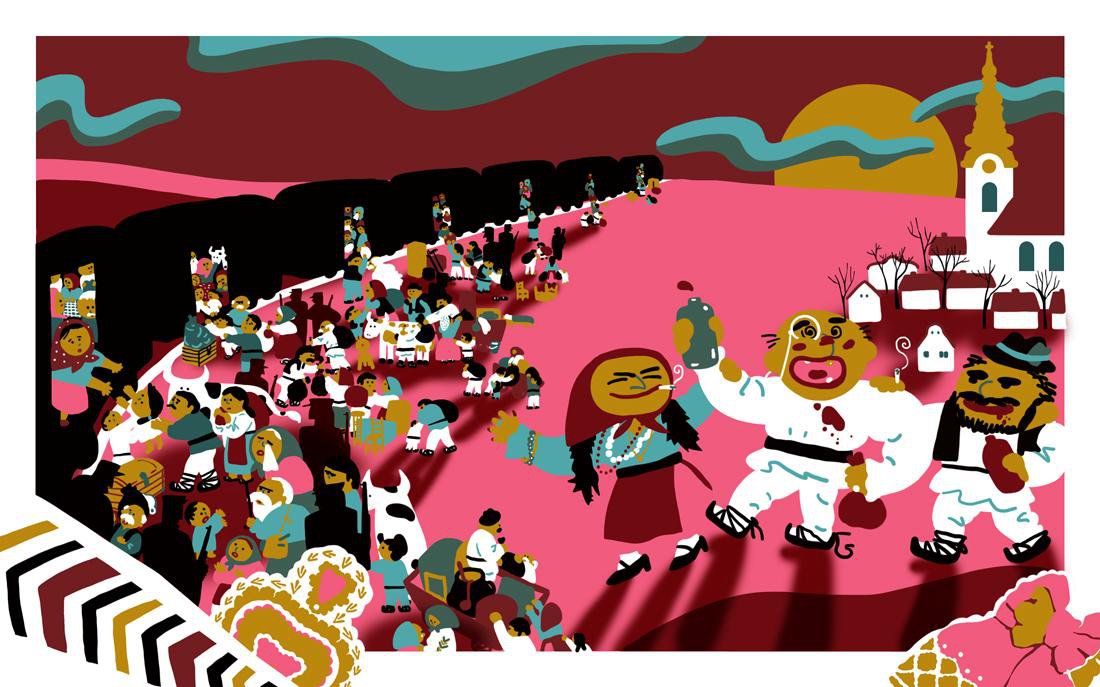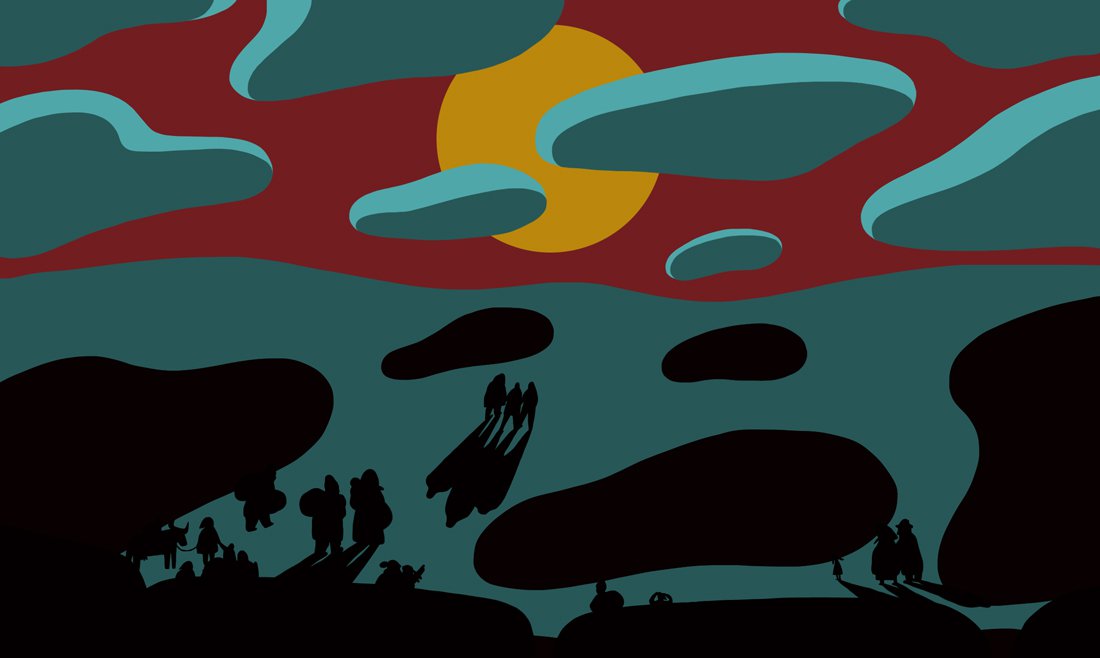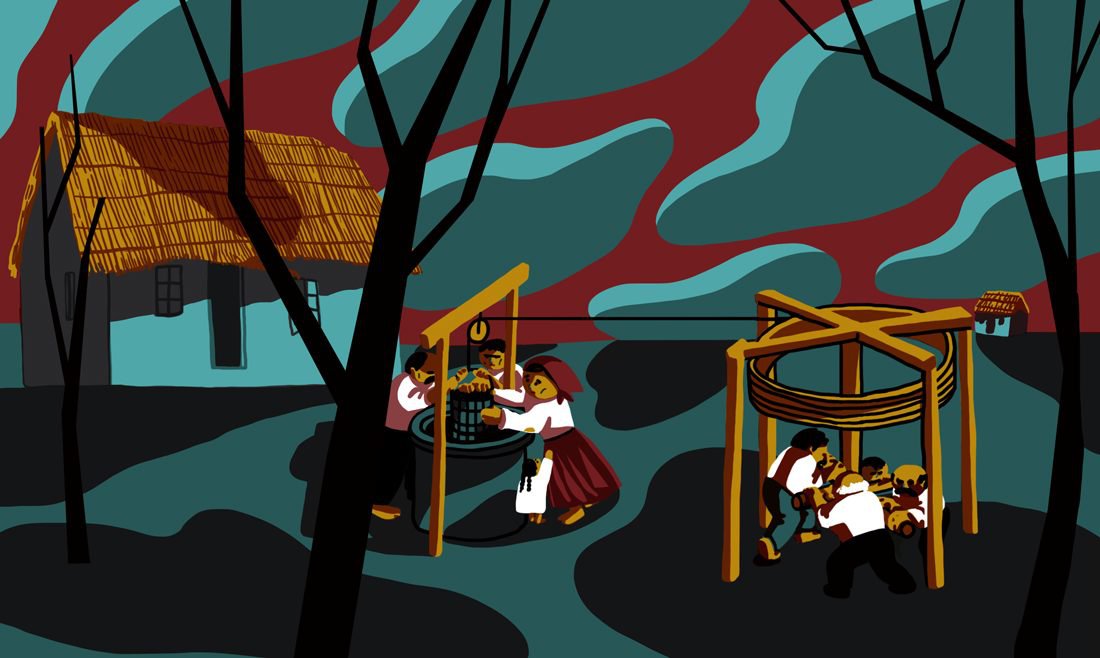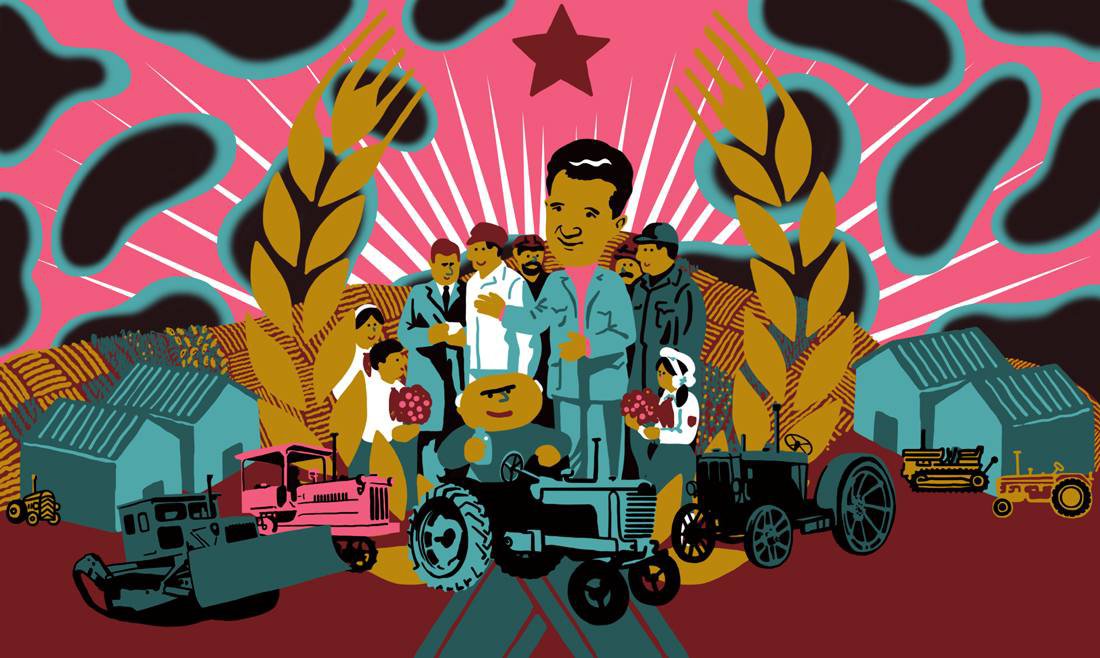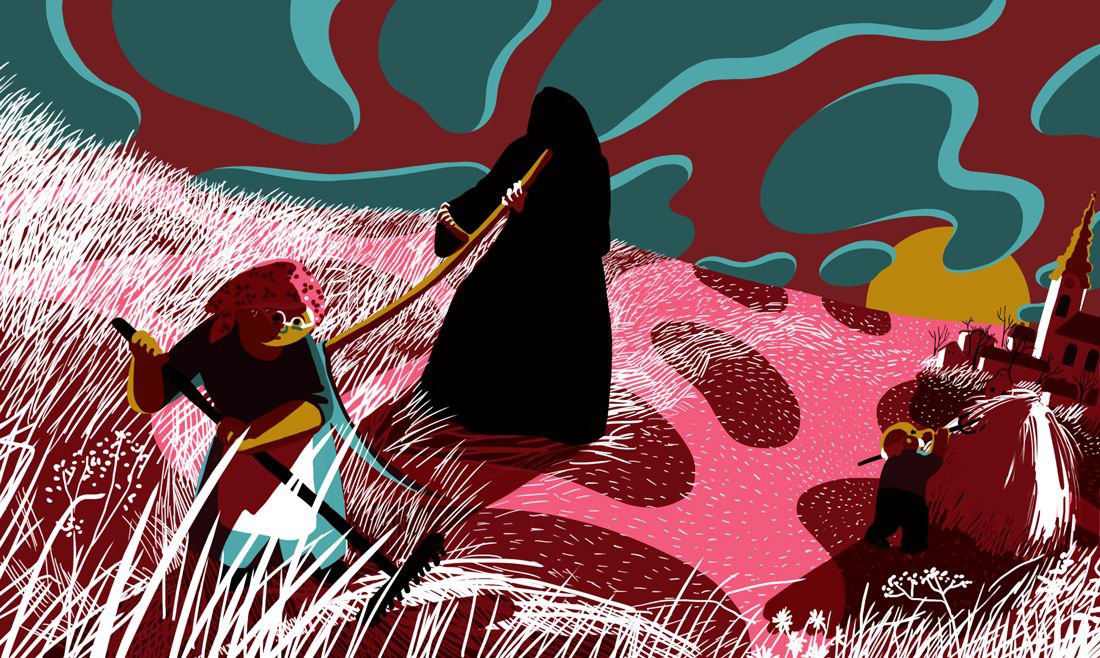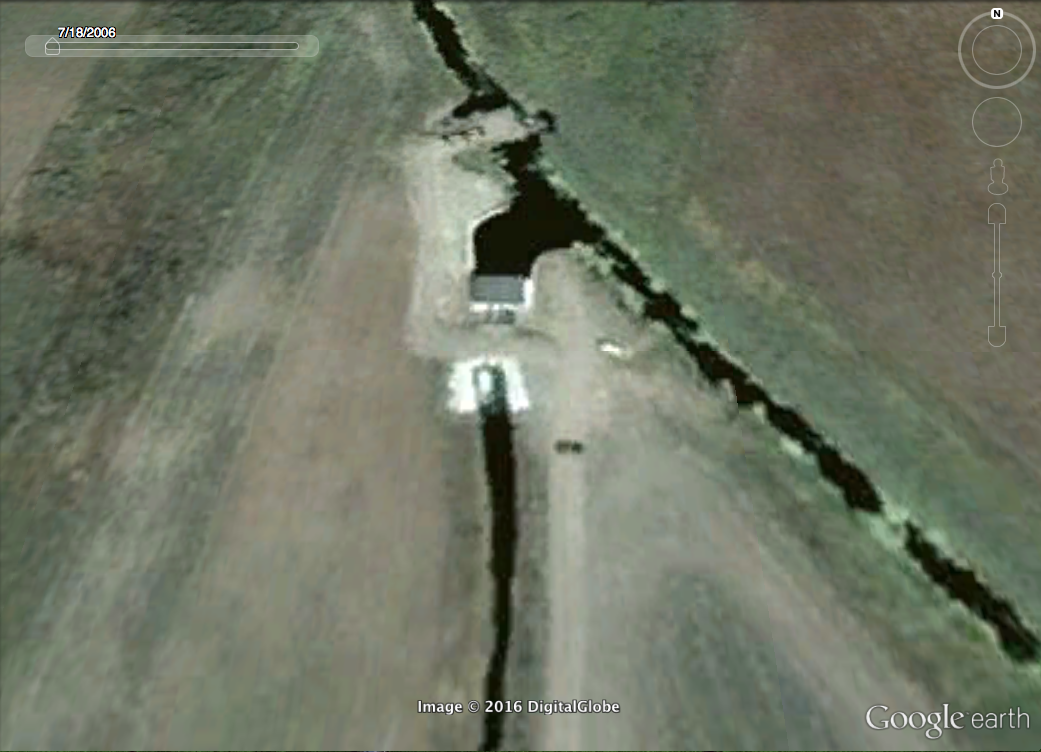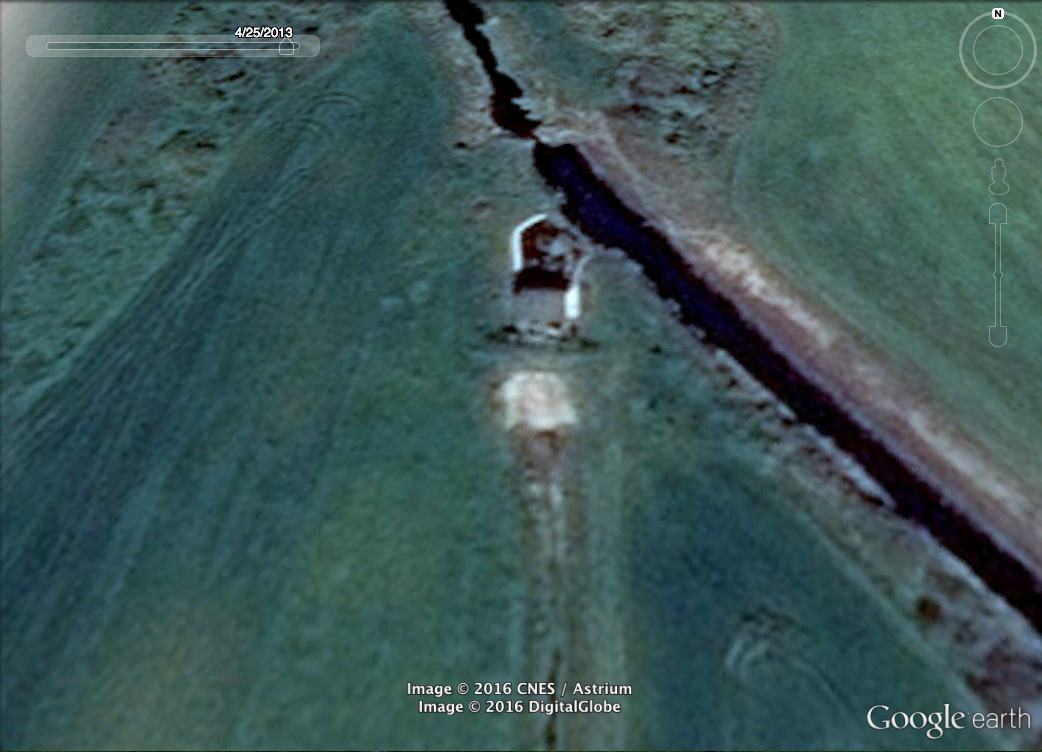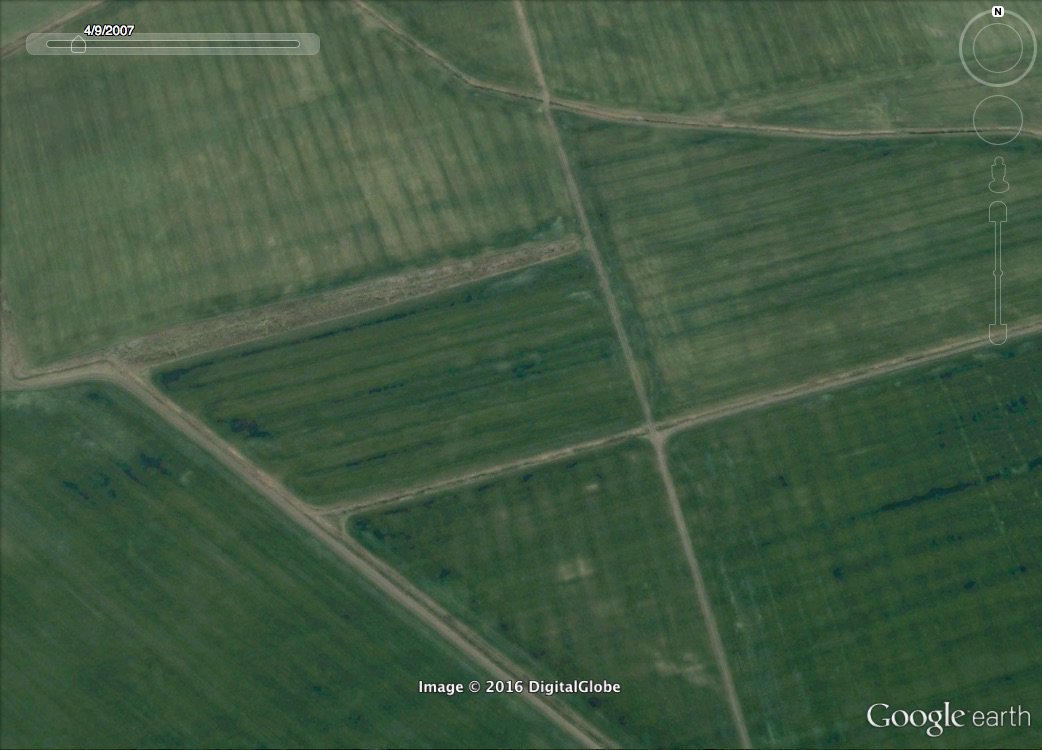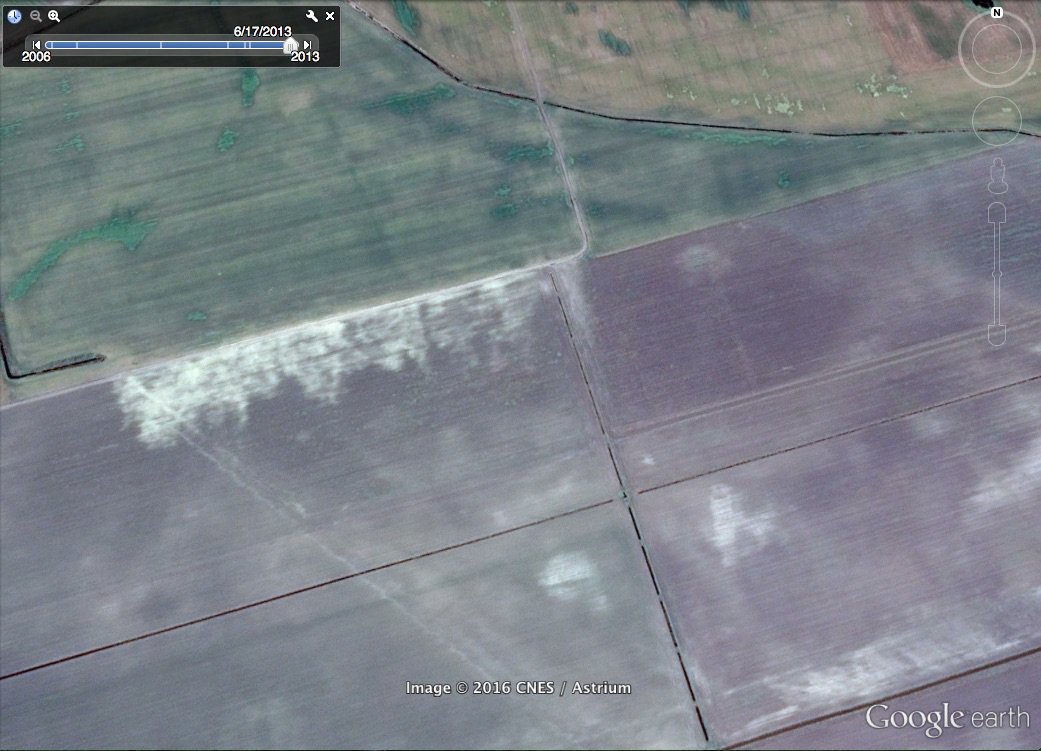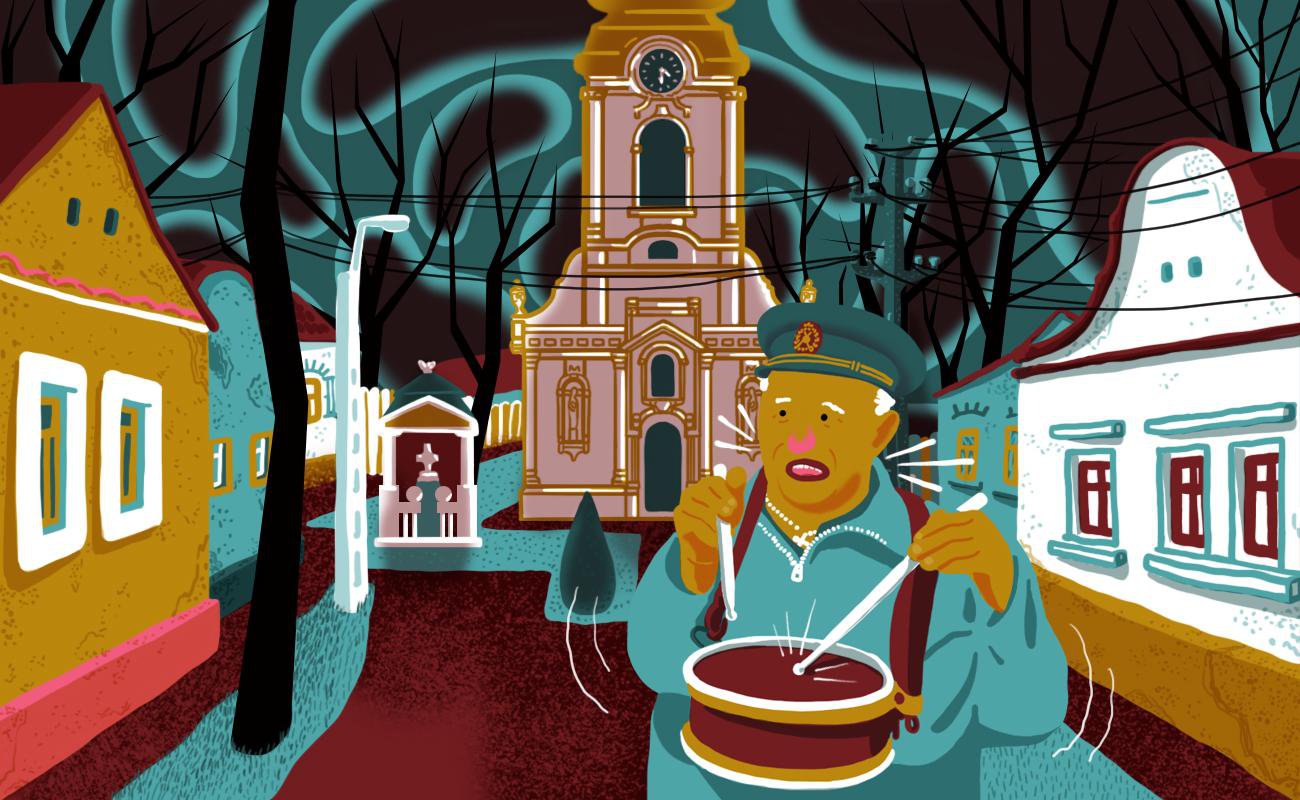The Death of the Field
Hanging up on a wall in front of us, the village of Dudestii Vechi looks like a pile of green patches speckled with red dots. These are gardens and houses. About 15 orange threads stretch out from the village, in multiple directions. These are the roads. At its base is a wide blue strip, bent with detours. This is the river Aranca surrounded by the villagers’ land.
Gheorghe Kalcsov, a local retired history teacher, has colored every furrow of land with a green marker. The parcels are small, perpendicular to one another, indicating enough land for everyone.
This is a copy of a detail from a Josephine map drawn around 1770, when the village was part of the Austrian Empire.
Kalcsov moves a finger up and down the map, cursing:
"The Italian destroyed everything!” he says. “Many of these roads are not there anymore! This was a forest, it’s not there anymore! somewhere around here [the Italian] put a dam and moved the water channels. And the river is drying up in summer. [The Italian] is taking the water for himself - and nobody cares."
The Italian is Luciano Martini, owner of Emiliana West Rom, an agribusiness working over 11,000 hectares around Dudestii Vechi, in Timis County, southwest Romania.
Martini is almost 78 years old and, although he regularly comes to Romania, he was not known by any of the residents with whom I spoke.
Since 2000, when they arrived in Romania, the Italians kept buying land in the Timis area, putting parcels together and levelling the earth.
They ploughed the old roads between Dudesti and its neighboring villages and built new roads alongside the irrigation channels.
They churned fertile black soil over unproductive yellow ground, thinning out the quality earth, while their bulldozers destroyed traces of ancient settlements.
This is the latest episode in the turbulent life of Dudestii Vechi and its people, a story of how a Romanian village is fragmented, stitched together by Communism, its people deported, its society torn apart by post-revolution politics, and then stitched together again by Italian investors.
"Too much pasture!"
In a small village near Dudestii Vechi, next to the Serbian border, a freight train is waiting.
The administrative director of Emiliana West Rom is Sebastiano Stoppa, a 34-year old Italian dressed in a red Lacoste sweater. He is watching the cows grazing in the distance.
He says there’s “too much pasture” there, and this land would be good for agriculture.
He is overseeing his Romanian crew loading up 1,060 tonnes of organic wheat onto the train, to leave to Italy.
In one year, since the Italians have taken over the rail abandoned by oil company Petrom, they have already filled about 20 trains.
In 2014, about 20 per cent of the wheat production went to Italy, the remainder was sold in Romania and the rest of Europe.
But this winter almost all will be sent to Italy, because the Romanian market isn’t profitable enough, argues Stoppa.
The Italians restored the gravel road to the railway. On the left side, the silhouette of a new silo is shining. On the right, beyond the enormous pasture, between the low roofs of the village is the steeple of a white church. Everywhere is flat and well-ordered plots, ready for the first snow.
"We found some disastrous land here," Stoppa says.
When they arrived, the Italians bid on the land of the former local state farm (IAS), then bought, plot by plot, land from the local villagers. In 2015, over their 11,000 hectares they seeded wheat, soy, sunflower, corn and sugar beet.
According to a document provided by the Agency for Payments and Intervention in Agriculture (APIA), Emiliana West Rom ranks second highest among recipients of EU farm subsidies in 2014 in Romania, with 6.6 million lei (1.4 million Euro) - and is the first among companies with foreign capital.
Overall, Italians are the biggest foreign investors in Romanian agriculture, according to the Italian Chamber of Commerce for Romania. But there is no official data on the total public land owned by foreigners. Estimates range between ten and 40 per cent of Romanian agricultural land controlled by foreign companies or individuals. Many are attracted by the EU farm subsidies.
"This trend is growing faster,” one land broker for foreigners tells us.
Often local intermediaries deal with village bureaucracy and negotiate with peasants, before selling the land on to investment funds, or agribusinesses, who merge them into mega-farms.
Since the revolution, land consolidation benefited from high-level support in Romania. The country has one of the largest rural populations in the EU, over 43 per cent in 2014 and the largest number of farms - 3.63 million. This is too many - and Romanian Governments see consolidation as the only chance to build modern agriculture.
The number of small farms has decreased continuously in recent years. Ecoruralis, an association supporting micro-agriculture, says three small farms close down every hour in Romania.
80 funerals versus 30 baptisms
According to a census from 2011, 4,203 people lived in Dudestii Vechi, but this number is plummeting.
Ioan Vasilcin, a priest in the village for over 50 years, has his own method of keeping a tally.
Every year he says that he attends about 80 funerals, compared to 30 baptisms.
"People are leaving,” he says. “About 100 leave each year, because young people who have completed high school are going to university. Most people living here are over 60 years old. Young people go to [the county capital] Timisoara, and if someone dies, the house stays empty. There are five or six empty houses on every street."
The village was called Besenova Veche until the 60s. Its Bulgarian translation, Star Bisnov, is still mentioned on panels in Latin and Cyrillic, at the entrances. Its wide streets make the village seem emptier than it is.
In the village, 60 per cent of the people are Bulgarian Catholics. Fearful of the Ottomans, the Bulgarian bishop Nikola Stanislavici fled over the Danube to Oltenia, and, in 1738, when the Ottomans continued to spread their influence through today’s Romania, they fled to the Banat region, then under the Catholic Austrian Empire.
Here the Governor gave each family 36 hectares of land. They prospered and founded new villages.
The region remained governed by Austrians and Hungarians until 1918, when Romania took over the Banat.
Now at the centre of the village, no more than an intersection, is the church, the village hall, the school and pub.
Here stands a statue of the Bishop Nikola Stanislavici, who holds up his hand in a blessing, as the cyclists, tractors and Italian SUVs drive past.
In the 1930s, there were 11,600 people in the village - almost triple today’s figure. This was a society of smallholders of between 12 and 18 hectares, and only a handful with more than 100 hectares.
The poor or "servants," as they were called in Dudesti, worked side by side with the wealthy peasants and supposedly lived decently.
Locals are misty-eyed about the Interwar period, and believe it was a period of social calm where owners and servants lived in harmony.
"[The owner] used to sleep in the barn with the servant, and he went to sleep later than the servant,” argues retired accountant Gheorghe Ghergulov.
These owners were the ‘Chiaburi’ - the kulaks. “These were good, hardworking people," adds Ghergulov.
The pensioner lives alone in a shabby and cold house. People come to him with complicated retirement and land recovery dossiers. He browses through their papers, narrows his eyes to read and helps if he can.
But although nostalgic about the 1930s, his family couldn’t escape poverty.
"My mother told me that our whole family worked until exhaustion,” says Ghergulov, “so they would get some money to buy some land, which they would have to work. (...) People didn’t use to live out of scams and thefts, they lived from their work. And if they didn’t have work, they wouldn’t have enough to eat.”
After the second world war, the Communists took control and created an atmosphere of class antagonism in the village.
"Why should other people be rich?’, people started to ask themselves,” Ghergulov says, “That’s when the robberies, the trickery, and the envy all began.”
Inventing the Kulaks
In 1949, Communist leader Gheorghe Gheorghiu-Dej introduced a Stalinist policy to support poor peasants and smallholders. At the same time, he fought against the ‘chiaburimea’ or rich peasant ‘Kulak’ class, accused of exploiting the poor peasantry. In the next period the seizures of ‘chiaburi’ wealth and the arrests began.
In 1951, the Party deported the ‘chiaburi’ to the almost deserted plains in the south-east of the country, the Baragan.
The exiled also included landowners, foreigners, alleged German army collaborators, people with relatives abroad, enemies of socialism, and political or criminal prisoners.
With the deportation of citizens from the regions near the Yugoslavian border, Dej wanted to prevent possible influence from the Yugoslav dictator Marshall Tito on this multiethnic region and limit the resistance against collectivization.
Not so many chiaburi lived in Dudestii Vechi, so the Communist authorities had to invent them. These new leaders were hated by the locals.
“The entire society fell apart,” says Gheorghe Kalcsov. “Drunks who used to play cards and go to prostitutes became important Communists, presidents and God knows what.”
Behind the closed doors of the cultural center, the new heads of the village put together a list of deportees, where kinship, personal disputes and jealousy were more important than whether the villager was a ‘Kulak’ or not.
"If I had some grudge and somehow I would now be in power,” says Kalcsov, “I would say: 'Fuck him, put him on this list, send him to the Baragan!”
The exodus
In mid-June 1951, freight cars began to gather in the train station of Dudesti, and rumors started to spread, wrote Rafael Mirciov in his book "The deportation camp. Pages from the camp of the Baragan (1951-1956)". Platoons of soldiers arrived in the village.
“On Sunday, in front of the church, the town crier of the village, Ioan Mirciov, beat the drum with the following unusual announcement: ‘We inform everyone that for the next five days nobody is allowed to go out on the field, because the army will carry out shooting exercises,’” Mirciov wrote.
That night, armed militiamen and soldiers went to the gates and asked people for their ID. In two hours, everyone in the house had to be present at the train station - 87 families, 443 people altogether. They were given no explanation.
Caradjov’s relatives were among them.
They had less than seven hectares of land. He was six years old at the time.
"They took my great-grandfather and my great-grandmother. And they told my father he could stay. My father never wanted to leave, but I wanted to leave, so my father said: ‘We're coming with you!’. We didn’t know where they’re taking us.”
They were allowed to take a cart with their belongings to the station, so they piled up a bed, a mattress, a few trays, a bedsheet, a pillow, and a whole ham. But some people didn’t have any food to bring.
As the Kalcsov family was preparing to leave, some neighbors opened the gate to their house, seized a pig and stole some wine.
The Communists soon confiscated their remaining belongings. The party found a use for everything.
When the convoy marched to the station, many villagers pulled down their shutters and sat in the dark, peeping out at the deportees from between the blinds.
The villagers piled up their belongings, including cows and horses, and themselves into freight cars. Once the trains were set in motion, the officers told them they were going 600 km to the Baragan. It sounded as alien as the Russian steppe.
The train would stop at times, and the children received tea and marmalade from the Red Cross. The women would milk the cows in the wagons and feed the children. The journey lasted a week.
They arrived at a hill near the high bank of the Borcea, an offshoot from the Danube, where the wind and the heat were fierce.
The settlement was named the Valea Viilor (Vineyards Valley), but there were no valley or vineyards.
Nor were there houses. There was only a large field, and 250 square metre lots, marked by stakes in the ground.
On the first day a storm came, and the exiles hid under their tables, and inside their wardrobes. Overnight, a sheepdog stole took the piece of ham Caradjov had brought from home.
In the beginning, the deportees drank water from the river, ditches and from puddles made by the hoof-prints of their horses.
In the nearest village, every house had a well, but the locals didn’t to give the newcomers water at first, as the villagers believed they were criminals, traitors, or kulaks.
But soon they began to build their own agriculture and industry. Every day, a little man called Ion borrowed a horse to dig a well 60 metres deep using a pulley and wheel system.
“The water we drew was full of clay,” Caradjov says, “and they were putting it in pots, leaving it to rest, before they would drink."
Some made their huts in the ground, which they covered with thatch-straw. Others started to cut down trees and cut sheaves of wheat to make their huts. Slowly, the deportees began to build houses.
One of them knew masonry, another carpentry, and another was a butcher. Soon they were allowed to work in the farms and gardens of the local collective. They baked bread in ovens dug in the ground, because the earth in the Baragan is thick and strong. They prepared the dough at night and during the day baked five kilograms of bread at once. The locals from Baragan hadn’t seen such bread before, and soon warmed to the exiles.
"These newcomers were some kind of outbreak of civilization," says Gheorghe Kalcsov, born in the Baragan, in 1953.
But the oldest could not forget their home. They needed a purpose in Baragan - and that was their land left in Dudestii Vechi. Ioan Petcov, over 80 years old, left almost 100 hectares, writes Rafael Mirciov in his book:
"In the Baragan, another villager, Ghita, a kin of his, begged Petcov for a hectare from his vast wealth, in return for help and assistance…”
Petcov refused the proposal, because he wanted to work his land when he returned.
However - meanwhile in Dudestii Vechi, the new socialist system confiscated the land and created state farms (IAS) or forced peasants to collectivize their plots in Agricultural Production Cooperatives (CAP).
The difference between the two was that in the cooperatives, the villagers would theoretically keep the right to their property.
Engineer Dancu Vasilcin’s grandfather entered the cooperative.
"You could in theory exit the CAP, but, in practice, no one was allowed to get out," says Vasilcin.
Until 1989, 411 IAS and 3,776 CAP operated in Romania. Officially, collectivisation was based on the willingness of farmers to work their land together.
In Dudestii Vechi, deportation was the best way to "convince" those left in Banat to give up their land.
"[Deportation] was the biggest step toward collectivization. When they [deportees] left, almost half of the village land became state property," explains Gheorghe Ghergulov.
The rest knew that - one way or another - they would lose their plots.
The Party representatives later admitted that they made mistakes. A document from 1952, at the National Archives, shows: "some organs of the Party and the People's Councils in these regions, applying mechanically the rules for identifying the 'chiaburi' households, wrongly placed peasant households in the category."
Responsible for those mistakes were the "hostile elements," reads the document. At Dudestii Vechi, the "hostile elements" included people from the village.
At the beginning of 1956, the Communists put the villagers in the Baragan into wagons and sent them back home.
When they all returned to Banat, the 80-year old Petcov turned up at the village with a scythe in hand, ready to work his 100 hectares - but the land had gone.
Some villagers even had to go to the court to take back their homes.
But as Romania industrialised, factories started opening in neighbouring towns of Sannicolau Mare and Timisoara, and many young people would break away from agriculture. Life in the city had new attractions.
A little revolution
Communism fell in 1989, with the execution of the dictator Nicolae Ceausescu on Christmas Day.
In the spring of 1990, Stoian Caradjov started his own little Revolution.
He remembered where his family’s land-plot has been, near the railroad track, where it was now part of a state farm.
Everyone else knew this place. During Communism, the plot was called "At the Gardener’s" after the family nickname.
Caradjov took a tractor from the state farm and went to till his plots. Many villagers confronted this sturdy man, going rogue with a tractor.
“What are you doing?” one of his neighbors asked.
“Can’t you see, I’m ploughing!” he said.
“What do you mean you’re ploughing?”
“Whose land is this?” said Caradjov. “Come here and I will show you!”
They couldn’t pull him off the tractor because he was burly and strong. Even now, in his 70s, his arms are as wide as shovels. He ploughed alone. Others, like Dancu Vasilcin, followed his example.
In 1991, the democratic state’s new Land Law did something that not even the Communists dared - to take over the land from the cooperatives that the peasants still owned on paper.
Then the officials gave each family between 0.5 and 10 hectares, with the democratic Romanian state taking over the rest.
This tore up the cooperative agreement, which said that when the farms would be
disbanded, each peasant could take his land.
"My grandfather joined the CAP,” says Vasilcin. “My father was also in the CAP. (...) Our parents knew where our own plots were.”
This created disputes as land has switched from peasant, to cooperative and back to a different peasant.
Then a new law in 2000, the Lupu Law overturned this law. This allowed the people of Dudesti to claim back the exact land they had lost during Communism.
But these plots had already been shared to former collectivist workers and to deportees, so the local committee members decided to share only the leftover plots, often far from the village - and on weaker land, including pasture - which was useless for anyone but a cow or a sheep.
The recipients of this land received only a certificate with the surface area - not the boundaries.
This lack of detail created confusion.
Gheorghe Kalcsov was entitled to two hectares of his plot, but this had already been shared to another peasant.
The village hall proposed to give him equivalent land surface, but this was far from his home.
A lawyer at the village hall convinced him to sell on the spot the right to these two hectares of land.
“He gave me money, and who knows what he did with it,” says Kalcsov, “but I never saw that land."
Whenever the villagers wanted to sell their land, the village hall would process the documents without delay. This is how the process of consolidation was taking place.
Meanwhile the machinery and infrastructure from the collective farms was stolen or destroyed.
"The accountants and the economists began sharing the equipment,” says Gheorghe Kalcsov. “One would steal a tractor, another was stealing a drill, or a plough. And if a farmer, like me, wanted to plough or work on his plot, he would be at their mercy. All the poor people took sheep, cows, horses from the cooperative farms. In a year they ate all the animals. Then they began to destroy the stables for bricks or wood, to cut down the trees in the fields. It was chaos!"
'You cannot be the same farmer after 50 years'
But people were happy to have their land back and regain control over their lives. It was a symbol of their dignity, American anthropologist Katherine Verdery writes in "The Vanishing Hectare," a book about the land restitution in a Romanian village in the ‘90s.
Ghergulov was still working at the village hall in the early 90s, and he was trying to temper the enthusiasm of the seniors who used to work the land before Communism.
If they were in their 20s when they remained landless, now they were in their 70s. Ghergulov once asked an old man:
“What do you think you can do with the land? You're not the same. 50 years have passed.”
And he was enraged.
“Why do you care?” he told Ghergulov. “Give me the land! I worked it, I can do it!”
They really tried.
A common vision in Romanian villages today is to see a peasant with a horse and a cart on a country road. But this was not a regular occurrence in the Communist era. This is something that began again in the 1990s.
Pensioners who lost their land in the 1950s bought horses and carts to work their land, taking up farming the manner which they had left it.
"It was the same as when they were children,” says Kalcsov. “They thought they could turn history around. Many fell ill and died of a heart attack on their field.”
Those under 40, like him, struggled to work on their ten hectares. But they had no access to markets to sell their products, no subsidies and had to borrow cash.
And when they had the money, they couldn’t find an available tractor driver to plough or sow. Even if they could borrow such a vehicle, it would often break down.
Ghergulov’s parents were still alive after the Revolution; and they took back their piece of land. They were ploughing corn with the help of some Roma neighbors, who had a donkey.
His mother was supervising the Roma, and Ghergulov would help after finishing work at the village hall.
A scene is stuck in his mind, which he says was the epitome of shame.
"I was looking at our own land, where my great-grandfather, who was the boss, let us enter only barefoot when the soil was soft. Now there were some kids: one was pulling a donkey, and the other one was pushing the animal, to try and force it to work. If the old man would have risen from the grave, he would have said we were crazy.
“That was the tragedy: people were enthusiastic and they would have worked. They tried. some of them died on the field. Because they making an effort at something they could no longer do. Even this year, someone passing-by some farmland saw an 80 year-old man lying down in his field, and thought he was resting. When he went up to him, he was dead."
The state did not help with any subsidies.
"Such demands ran counter to the plans of international organizations to reduce the power of postsocialist states and convinced policy-makers that these populations were prisoners of a socialist mentality,” writes Katherine Verdery. “As it happened, however, village farmers understood the situation very clearly: if the state did not help them as the states of Western Europe helped their own farmers, these villagers could not succeed.”
After a while, Ghergulov began to hear more often phrases such as "I want to sell the land”. In Dudestii Vechi elders were dying or becoming powerless.
The younger villagers wanted a western lifestyle, second-hand BMWs, modern appliances, TVs and double-glazed windows.
In the early 2000s, when the Italians came, prices were at about 200 Deutschmarks per hectare, which meant about 100 Euro in today's money. They bought up.
Many who had no historical connection to their land sold first.
“Those who had land - which was historically their property - rarely sold,” says Cardjanov. “When the elders died, they heirs were in cities like Timisoara and Arad, they didn’t live here. Then they sold the land.” Most of the former deportees kept their land.
One of Kalcsov’s neighbors had five or six hectares.
"He worked it in the early days, but after that, he sold the land, and bought two cars. Because the cars were already old, his hens now sleep on the seats and in the boot.”
Petru Uzun is working as a lawyer at Dudestii Vechi village hall, and is in charge of all the announcements for selling land. With the money for a plot of land, they bought a TV. Since 2000, the price of land has increased over 40 times.
"It was a mistake,” says Dancu Vasilcin. “What can we do?”
Enter the Italian
Paolo Rocchi is the former director of Emiliana West Rom. In the early 2000s, he remembers that people in Dudestii Vechi were “kind”.
The Italians first bought the remains of the state Farm and started renting plots from owners. "And once we had rented, slowly people sold," he says.
It was more profitable in the short-term for them to sell 20 hectares of land in Dudesti and buy an apartment in the city "than to keep it here, where they have no income," says Rocchi’s successor, Sebastiano Stoppa.
We are passing through Dudestii Vechi in Stoppa’s SUV, as he shows me the Italian’s land.
"My boss paid for each hectare from his pocket,” he says. “He had no help. He dreamed of having the most modern and most beautiful farm in Europe.”
On both sides of road there are irrigation canals with fresh cement and beyond the land is levelled. A long and intricate sprinkler system on huge wheels is poised for work.
The Italians collected as many ownership certificates as they could. But there were still gaps in the land which belonged to smallholders.
Stoppa is sensitive about criticism of the Italian company’s actions in the zone. In his defence, he compares what they have done in Dudestii Vechi with the work of an artist. In this comparison, he says the land around the village was like a pile of dead leaves.
"If a Frenchman comes and takes the fallen leaves, and with those leaves he makes a beautiful painting and sells it, you can be sure that someone will come to say 'he stole our leaves!’. That's the mentality.”
Foreigners had the advantage of entering Romania with investment capital and a long-term vision, while the locals were living from day to day on their meagre plots.
Dimitrie Musca is a farmer who created an agricultural complex in Curtici, Arad county.
He says that Romanian farmers were always at a disadvantage to foreign investors.
"They bought a tractor, bought a combine, then bought a warehouse, and when they came to buy the land they had no more money,” he says. “They [foreigners - n.r.] knew what to do and came with money.”
This capital allowed the Italians to reshape landscapes, level the land and stop the water supply from reaching the village.
Invading the land
Gheorghe Kalcsov picks up a pen and paper, to show me how they did this. His family had about ten hectares of land in one place.
Kalcsov claims that the Italians moved the poles - which demarcated the boundary of their land and his - a few metres onto his plot, pushing his space into adjacent empty land, which he argues is of an inferior quality.
He could not afford to hire a lawyer and argues this strategy is meant to make landowners sell up and quit.
Stoian Caradjov has a piece of land between two lots belonging to the Italians. When they pass by with their big equipment and vehicles, they drive over his land. When they have used herbicides, it has spread on his land and destroyed his harvest. One year, he lost half of his sunflower production.
The Italians compensated him with money, but the fact that they did this on purpose bothers him.
"They want you to leave them alone,” he says. “That’s what they want. They want to occupy everything. Well, that’s not possible. Why should I leave my own land?”
The Italians offered to buy his four and a half hectares next to the railway, where he has a cabin. They offered to exchange him double the surface area, so he would leave.
"And I told them: 'I want the exactly same area, but in Italy!'."
Once the Italians put together the parcels, they dug new channels that cut the land into large rectangular perimeters, and brought water from the river Aranca to irrigate the land.
'They switched off our river'
But they also practically put a tap on the water from the river, which is the natural source of water in the region.
In 2009, a year with a dry summer, the corn fields belonging to the company, situated east from the village, were irrigated with water brought from the pumping station Aranca, according to a report published by the Transnational Institute in 2013: “Emiliana West Rom then blocked the [villagers’] access to the pumping station, in order to provide sufficient water for the [Italians’] crops."
The dam at the pumping station is a barrier of earth with a pipe, through which the water flows to Dudestii Vechi. This pipe has a valve controlled by the company.
The Italians can also destroy the barrier during periods when they do not need water, explained the report.
The process is visible in the history of images on Google Earth.
"They simply diverted and switched off the Aranca,” says Dumitru Pop, a villager in Dudestii Vechi. “Our community lived off that water.”
ANIF Timis, which sells the water to Emiliana West Rom, claims "this is a drainage channel” and they are open to being contracted to supply water to the villagers - if they want to pay.
But this is a natural river which has existed on maps at least since the 18th Century.
Once the Italians amassed land and dug new channels, they ploughed the old roads of Dudestii Vechi and the neighboring villages and built new ones suited to their needs.
Now people in the village have to travel dozens of further kilometers to reach their plots or visit their relatives in the other villages.
"That's an abuse,” says Kalcsov, “because [the Italian] never bought the road, there was no one to buy it from.”
In a phone-call, I tried to approach to Paolo Rocchi about the subject of the destruction of the roads, but he refused to talk about this issue, and hung up the phone.
The changes in the landscape can be seen on Google Earth.
In 2006 the strips of narrow and winding roads between villages were still visible. In 2013, only a few roads over the big slices of land of the company are evident, and there are only a few traces of the old roads.
The mayor of Dudestii Vechi, Gheorghe Nacov, says that Emiliana has obtained approvals from Timis County Council for those works, but no one consulted the locals. Nacov now says he is working on "regulating the situation" and if it doesn’t work in a peaceful manner, they will go to court.
No room for the village
Today's agriculture is an industry, and there is no room left for the village. In his guest room with chairs covered in ragged leather, with a large wall clock with the sound of a cathedral belltower, under a light that seems to belong to another century, priest Ioan Vasilcin says that there is something he cannot understand: today, when so many machines are helping and everything is done so easily, it should be better for the people, but it is not.
He remembers that in his childhood, peasants used to work the land with hoes and animals, and they still had time to get together and talk to each other:
"On 1 November, each host would be done with the agriculture and they would gather together and kill the pigs. And now we are all running about and do not have time to talk. Why is that? We ought to have more time. People should be able to leave work and say: 'I am done, now I am free'. But now there's nobody on the street.”
In Dudestii Vechi, the rhythm of the day is the one of factories, not of agriculture. Many young people are working 13 kilometres in Sannicolau Mare, and the village is a dormitory settlement for another town.
Each morning and evening, the buses paid by industrial companies stop at the station in the center and drive their staff to the factories.
"If there were would be no factories in Sannicolau Mare, Dudestii Vechi would starve, it would disappear," Dan Ciobotaru, an archeologist at the Museum of Banat, tells me.
Kalcsov takes me on a tour around his garden. In the middle there is a mini-reservoir made from plastic water bottles. Last summer he kept water lilies there. Wooden stakes hold up tomato vines, and he grows celery and carrots. He is taking care of a few grapevines. Some of the branches died, but he supplemented them with some muscadine from Oltenia, a black variety of grape. Pots are hanging from the branches. For two months he mulled brandy, which he sold, and received some money. Two 150-pound pigs snuffle the ground nearby. Chickens prance around the barn. Later, he will clean up the entire garden and in spring he will start again. He has ten hectares of land, in four separate places. He is working one, and has leased the rest. "I’m not at the disposal of anyone,” he says, “I do it all myself. Should I grumble?"
Now most of the people have sold their plots of land. And for those who are retired or without a job, they depend one way or another on the village hall.
The village has a town crier who beats a drum to make public announcements.
Iosif "Vinti" Ianculov lives on welfare in a row of houses near the cemetery. He used to work as a guard at the village hall, and has been through four mayors, as he says.
But in 2013, the village hall fired him and hired a security company instead.
If they had kept him on for two years and three months more on any kind of odd job, he could have retired.
"But they didn’t want to keep me because they said I'm not one of them," he says.
He had a hectare and 11 acres from his father and one hectare from his mother, but he sold them in 2006 or 2007 for 400 Euro.
In order to receive unemployment benefit, Vinti has to work for four days a month for the village hall, as a sort of handyman. Every time they call, he puts on a military cap, beats the drum and calls out to people in the street the local news and small ads.
It is November 2015. The phone rings: the village hall asks him to announce that tonight at 5:30 there is a rally to commemorate the people who died in a night-club fire in Bucharest.
"They will give me a paper with what I have to say,” he says. “I do not know what to say myself."
When he is walking through the village with his drum, Vinti hears a number of complaints about the mayor. People would sometimes pick on him for what the mayor does or doesn’t do.
"They complain about the roads, about the bridges,” he says, “but the mayor cannot do everything at once.”
The current mayor, Gheorghe Nacov, was re-elected in 2012 with 1,347 votes. In a village shrinking by the day, where the land is evaporating, he gains votes from public works. These include building a floodlit stadium, named after Bulgarian footballing hero and Barcelona alumni Hristo Stoichkov, and paying for buses to take the faithful to monasteries.
"This village works by employing as many people as possible,” says Ivan Vasilchin, artist and local activist. “If you give two lei to someone, he is already yours. And all his family would vote for you because you gave him a crumb of bread.”
Without land, the power of the mayor increases. And this creates a chain of poverty from which it’s really difficult to get out.
Vinti reads out the small ads. Commercials for selling land are now few and far between. Most of the land has been sold. Last year there was one announcement.
He asked if any villagers wanted to sell their land.
He beat his drum once, twice and then a third time - but nobody came.
However there are many houses for sale in Dudesti.
But Vinti can keep shouting and beating the drum to see who wants to buy a house. No one does.
There are empty houses for everybody.
This article was produced during a Milena Jesenska Visiting Fellowship sponsored by the Institute for Human Sciences, Vienna and Erste Foundation, Vienna, between October and December 2015.
Follow us
